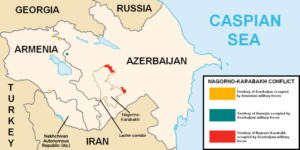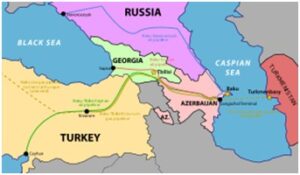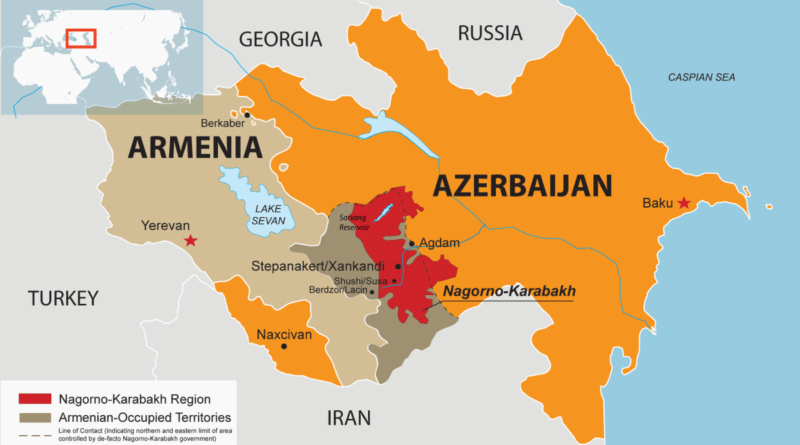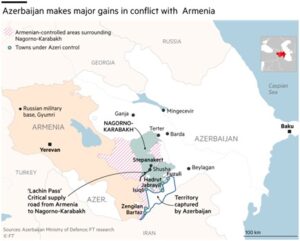Armenia – Azerbaijan Conflict and its Impact on Geopolitics- Implications for India by Maj Gen AK Chaturvedi (Retd)
![]()
Introduction
The Nagorno-Karabakh conflict is an ethnic and territorial conflict between Armenia and Azerbaijan over the disputed region of Nagorno-Karabakh and seven surrounding districts, which were though part of Azerbaijan was controlled by the self-declared Republic of Artsakh, but are internationally recognized as part of Azerbaijan. It is an enclave, whose only overland access route to Armenia is via the 5 km (3.1 mi) wide Lachin corridor.
Map-1: Conflict Zone
Source: Public Domain, https://commons.wikimedia.org/w/index.php?curid=1476627
The Origin of Conflict– The conflict has its origins in the early 20th century. Under the erstwhile Soviet Union, the then General Secretary of the Communist Party and the Chairman of the council of ministers; Joseph Stalin decided to make the Nagorno-Karabakh region an autonomous oblast of Soviet Azerbaijan. In February 1988 the parliament of the Nagorno-Karabakh Autonomous Oblast passed a resolution requesting transfer of the oblast from the Azerbaijan SSR to the Armenian SSR. Azerbaijan rejected the request.[1]Following the revocation of Nagorno-Karabakh’s autonomous status, an independence referendum was held in the region on 10 December 1991. The referendum was boycotted by the Azerbaijani population and but for a minuscule minority, all others voted in favour. In early 1992, following the Soviet Union’s collapse, the region descended into a civil war[2]. The First Nagorno-Karabakh War resulted in the large scale displacement of population from both Azerbaijan and Armenia[3].The 1994 Bishkek Protocol brought the fighting to an end and resulted in significant Armenian territorial gains: in addition to controlling most of Nagorno-Karabakh, the Republic of Artsakh also occupied the surrounding Azerbaijani populated districts. The terms of the Bishkek agreement resulted in a state which was far from peaceful. A long-standing international mediation attempt to create a peace process was initiated by the Organization for Security and Co-operation in Europe (OSCE) Minsk Group in 1994 but except for an uneasy peace nothing, much was achieved. The United Nations Security Council (UNSC) adopted a number of resolutions in 1993 calling for the withdrawal of “occupying forces” from the territories surrounding Nagorno-Karabakh[4], and again in in 2008 the United Nations General Assembly (UNGA) adopted a resolution for the withdrawal of Armenian occupying forces[5]. Ironically the co-chairs of the OSCE Minsk Group, Russia, France and the USA, voted against it[6].The current conflict started on 27 Sep 2020 and after a bloody war of 44 days, on 09 November 2020, a ceasefire agreement was signed by the President of Azerbaijan, the Prime Minister of Armenia, and the President of Russia, ending all hostilities in the zone of the Nagorno-Karabakh conflict from 10 November 2020, 00:00 Moscow time[7].The President of Artsakh, also agreed to end the hostilities. Under the terms of the deal, Armenian forces were to withdraw from Armenian-occupied territories surrounding Nagorno-Karabakh by 1 December 2020, while a peacekeeping force, provided by the Russian Ground Forces would be deployed for a minimum of five years along the line of contact and the Lachin corridor. Additionally, Armenia undertook to “guarantee safety” of passage between Azerbaijan’s Nakhchivan exclave and mainland Azerbaijan in both directions, while Russia’s border troops were to “exercise control over the transport and communication”.[8]The ceasefire agreement stipulated that the cease-fire should pave the way for the talks on settling the conflict. Russia had co-sponsored the peace talks on Nagorno-Karabakh together with the United States and France as co-chairs of the OSCE Minsk Group.[9]
The current escalation marked the first time when Turkey as an ally of Azerbaijan, took a high profile in the conflict, offering strong political and material support. Over the past few years, Turkey has provided Azerbaijan with state-of-the-art weapons, including drones and rocket systems that helped the Azerbaijani military to outgun the Nagorno-Karabakh separatist forces and the Army of Armenia in the latest conflict.
Armenian officials charged that Turkey was involved in the conflict and was sending Syrian mercenaries to fight on Azerbaijan’s side. Turkey has denied deploying combatants to the region, but a Syrian war monitor and three Syria-based opposition activists have confirmed that Turkey indeed had sent hundreds of Syrian opposition fighters to fight in Nagorno-Karabakh.[10]Turkey’s involvement in the conflict raised painful memories in Armenia, where an estimated 1.5 million had died in massacres, deportations and forced marches that began in 1915 as Ottoman empire officials at that point in time were worried that the Christian Armenians would side with Russia, which was Turkey’s enemy during the World War I.[11]Turkey’s high profile in the current conflict worried Russia, which has a military base in Armenia. The two countries (Russian Federation and Armenia) are linked by a security treaty obliging Moscow, to offer support to its ally, if it comes under aggression. At the same time, Russia has sought to maintain strong economic and political ties with oil-rich Azerbaijan and ward off Turkey’s attempt to increase its influence in the South Caucasus without ruining its delicate relations with Ankara.
Russian President Putin and Turkish President Recep Tayyip Erdogan have negotiated a series of deals to coordinate their conflicting interests in Syria and Libya and have expanded their economic ties. Last year, despite being a member of NATO, Turkey took the delivery of the Russian S-400 Air Defence missiles, a move that angered Washington.A cease-fire in Nagorno-Karabakh would allow the Kremlin to stem, Turkey’s bid to expand its clout in Russia’s backyard without ruining its strategic relationship with Ankara. While Turkey has aspired to join the Minsk Group talks as a co-chair, the statement issued by Armenia and Azerbaijan contained their pledge to maintain the current format of the peace talks.
Relevance of Azerbaijan in World Petroleum and Gas Supply
The petroleum industry in Azerbaijan produces about 873,260 barrels (138,837 m3) of oil per day and 29 billion cubic meters of gas per year as of 2013.[12]
Map-2: Oil Pipelines
Source: https://en.wikipedia.org/wiki/Pipelines_in_Azerbaijan
Oil Pipelines-There are three main oil pipelines; the first one; is Baku- Grozny- Tikhoretsk- Novorossiysk which transports Azerbaijani oil into the Russian Federation to the Black Sea port of Novorossiysk, intended to transport 2.5 thousand tons of crude oil per day; the second one; is Baku- Tbilisi- Supsa, which transports Azeri oil from Azeri- Chirag- Gunashli fields through Baku and exports 15 million tons of oil per year to Western countries; the third one is; The Baku–Tbilisi–Ceyhan pipeline which transports 50 million tons of oil to the Turkish port of Ceyhan on the Mediterranean Sea for export to European markets.
Gas Pipelines- There are three major gas pipelines. The first one is Baku- Tbilisi-Erzurum pipeline to transport 30 billion cubic metres of gas per year from Shah Deniz field in Azerbaijan and also gas from Turkmenistan to the Turkish terminal of Erzurum for onward transportation to Europe; the second one is; Trans Anatolian Gas Pipeline (TANAP); to transport 31 billion cubic metres by 2026 to Turkey; the third one is; Wholly outside Azerbaijan, the Trans Adriatic Pipeline project (TAP) would connect TANAP to European pipelines.
Turkey- Azerbaijan Equation
The alignment and terminal points, confirm that the oil as well as gas from the Oil/ gas fields of Azerbaijan are very important for the end-users which in most cases is Europe and also for Turkey and Russia to earn revenue for transit. This particular aspect makes Azerbaijan, highly important; for both Russia and Turkey. No wonder, both the countries are trying to woo Azerbaijan. Turkey‘s GDP growth had been robust till 2018 when a currency and debt crisis pushed the economy into recession. The pandemic due to COVID-19 has worsened the matter further. IMF projects real GDP growth for Turkey for FISCAL 2020-21, as -5.0 per cent. That is why Turkey is looking for ways and means to improve its fiscal health. That is one reason why besides, transit fees on account of oil and gas pipelines in recent times, Turkey is trying to make up for the revenue loss through arms export. The Russian Situation is no better either. Russian economic situation is no better either and it is projected to grow at -4 per cent in 2020.
Presently party in power in Turkey is AKP. The AKP’s vision; as such is shaped by Turkey’s philosopher-king, Foreign Minister Ahmet Davutoglu, who summarized this position in his opus “Strategic Depth,” in which he wrote that “Turkey’s traditionally good ties with the West…are a form of alienation” and that the AKP would correct the course of history, which has disenfranchised Muslims since the collapse of the Ottoman Empire. To this end, the AKP took advantage of Turkish anger with the USA’s war in Iraq, terming it as an attack on Muslims (Turks included), which has reinforced their bipolar vision in which one pole is the USA and the other pole is Muslims Umma. Turkey envisions itself as the self-appointed leader of the “Muslim world.” They feel that they are most suited for this role because they are the largest economy and most powerful military among all the Muslim nation. After years of successful de-Kemalization (in other words, jettisoning secularism), the only obstacle that remains in Turkey’sdesign is to convince the Muslim majority countries to accept Turkey as the leader of the Muslim World in place of Saudi Arabia and for this, they have the backing of China and Pakistan. In recent years, Turkey has intervened militarily in Syria, Libya, and Northern Iraq, and has pursued a more assertive approach in a dispute with Greece and Cyprus over energy rights and maritime boundary disputes in the Eastern Mediterranean Sea. Moral and material support to Azerbaijan by Turkey is a step in that direction. Turkey and Azerbaijan have strong economic, military, cultural and linguistic ties. Erdogan has invoked the saying that the two countries are “One nation, two states”.No wonder, to enhance its influence in the region Turkey wants a role in the ceasefire talks.
Military ties have deepened significantly between Turkey and Azerbaijan over the past 10 years as the oil-and gas-rich state has spent heavily to gain military superiority over its much poorer neighbour Armenia. Turkey has become bolder in its support for Azerbaijan – particularly over the past year. The figures compiled by the Turkish Exporters’ Assembly, which groups more than 95,000 exporting companies in 61 sectors, show Azerbaijan bought $123 million in defence and aviation equipment from Turkey in the first nine months of 2020. Most of the purchases of drones, rocket launchers, ammunition and other weapons arrived were after July when border clashes between Armenian and Azeri forces prompted Turkey and Azerbaijan to conduct joint military exercises. Turkey trains officers in the Azeri armed forces and it has become Azerbaijan’s third-largest supplier of weapons after Israel and Russia – Moscow arms both Armenia and Azerbaijan, despite having a defence pact with Armenia.
Impact on the Geopolitics of the Region– The above discussion confirms that this conflict was an effort of Turkey to assume the role of a dominant player in the power politics of the region besides creating ways and means to safeguard her economic interests. Here, it is interesting to note, that there is a deafening silence of the USA and her tacit support in terms of Arms to Azerbaijan from Israel. The aim of the USA appears to be to help Turkey indirectly so that Russian influence in the region reduces and the economic interests of the Russian Federation are also impacted in what is believed to the underbelly of the Russian Federation. Interests of Israel and Turkey appear to be co-terminus in keeping Iran marginalised in the region. In this connection, it is interesting to note that despite Azerbaijan and Iran both being Shia Muslim majority countries, yet influence of Iran was found to be minimal in the region.
Changing Contours of Battle Field
During this battle whileArmeniaused traditional weapon systems like tanks, Artillery guns, Missiles, Azerbaijan used Drones. It has emerged in post-conflict analysis that when Armenians opened their Radar and Missile batteries, Azerbaijanis homed on to them and destroyed them. This helped Azeri Forces to destroy the entire Air Defence system and missile defence of Armenia. In all, Armenia lost 185 tanks, 45 armoured fighting vehicles, 44 infantry fighting vehicles, 147 towed artillery guns, 19 self-propelled artillery, 72 multi-barrel rocket launchers and 12 radars. Azerbaijan’s losses were only one-sixth of this. The result was quite different from what happened during the last time when the two adversaries had clashed in 1992-94. It needs to be noted that by the end of the war in 1994, the Armenians were in full control of most of the Nagorno-Karabakh enclave and also held and controlled approximately 9% of Azerbaijan’s territory outside the enclave. As many as 230,000 Armenians from Azerbaijan and 800,000 Azerbaijanis from Armenia and Karabakh had been displaced as a result of the conflict, essentially cleansing Armenia and Karabakh from Azerbaijanis and Azerbaijan of Armenians. A Russian brokered ceasefire was signed in May 1994, leading to diplomatic mediation.
Map-3: Progress of the Army of Azerbaijan
Source: IBID-30
The situation was quite different in 2020. Equipped with far superior military equipment and an airborne fleet of Israeli and Turkish drones, as against weaponry of the 1970ies and eighties used by Armenia, Azerbaijan inflicted major damage on Armenian forces and made significant gains, seizing back land surrounding Nagorno-Karabakh previously occupied by Armenian forces. In fact, by the time the ceasefire came into effect on 09 November, the Azeri troops were just 30km from the winding mountain pass, and well within firing range. It is claimed by Azerbaijan that almost 1500 Square Km of the area earlier held by Armenia had been captured by Azeri Forces. One of the reasons for Armenia not being able to tackle Azerbaijan’s drones was that their Air Defence systems were not integrated with the Modern RADARS. Azerbaijan claimed that their drones in late September had destroyed One of the S-300 Missile batteries of Armenia. Azerbaijan used extensively drones, supplied by Israel and Turkey.
Azerbaijan basically used Bayraktar TB2 Drones supplied by Turkey and Kamikaze Drones supplied by Israel. These can carry a payload of 55 and 15 kg respectively. It is also believed that besides equipment, Azerbaijan had also been receiving advice and training from Turkey for the effective utilisation of the equipment. The sourcing of weapon systems by Azerbaijan was from Turkey, Israel and Russia. It has been reported by the Stockholm International Peace and Research Institute (SIPRI) that in the last decade, Azerbaijan has spent the US $24 billion on equipment acquisition as against US$ 4 billion by Armenia. This shows that Azerbaijan was better prepared for the conflict on a modern battlefield as against Armenia who was still preparing for the battlefield of the last decade.
Implications for India and the Way Ahead
Drones have been used for surveillance and logistic support in past. In recent times drones have also been used by Pakistan for dropping of Arms and Ammunition to support cross border terrorism. However, in view of the close relationship between Pakistan and Turkey, there is a very strong possibility that in near future, use of drones supplied by Turkey for offensive purposes by Pakistan cannot be discounted.
In view of the Azerbaijan-Armenia conflict and also an effective use of drones by the US in the AfPak region presents a future battlefield that is likely to be quite different from the battlefields of the past. In the last few years the US has used Armed Drones in Syria, Iraq, Yemen, Somalia, Libya, Afghanistan and Pakistan for both; against terrorists as well as in conventional war. Chinese made drones have been extensively used to combat extremism outside China. China is believed to have developed a truck-mounted barrage swarm launcher capable of putting 48 attack drones into the air. Even UK, Iran, UAE, North Korea, South Africa, Italy and Nigeria are reported to be having combat drones. Drone built by Turkey and Israel has already been used by Azerbaijan in the recent Azerbaijan-Armenia war very effectively. Turkey also is having a Swarming Capability to use swarms of drones for offensive purposes.
Indian Capability– India has recently gone for MQ-9B Sea Guardian unarmed drones for the Indian Navy. These are maritime variants of the Predator MQ-9 Unmanned Aerial Vehicle (UAV). It has a 3600 maritime surveillance RADAR and an optional multimode maritime surface search RADAR. Also, a proposal to procure 10 UAVs for each of the three Services including armed drones is there in the pipeline. This confirms that the Indian Armed Forces are indeed serious about the use of drones for surveillance, logistics and armed usage in future. India has been collaborating with the US since 2018 under the Defence Technology Trade Initiative. India is also developing drone swarms that can be deployed from combat air crafts. A Jaguar Strike Aircraft will carry four pods each containing Alfa-S drones, capable to attack the enemy’s Air Defence. It is believed that the project is being fast-tracked in view of the standoff in Ladakh and reported deployment of Surface to Air missiles by China. In fact, the Indian Army during the 73 Army Day Parade on 15 Jan 2021, displayed a swarm of 75 drones destroying a variety of simulated targets in a Kamikaze attack. The accompanying commentary mentioned that the swarm was capable of autonomous operation over a distance of 50 km. Besides offensive operations, this swarm could also be used for reconnaissance and logistics purposes. This indeed was a demonstration of technologies entailed, which will shape the future battlefields. It is reported that the goal of India would be to have a 1000 drone swarm.
Way Ahead– However it needs to be noted that drones are quite susceptible to enemy action. Therefore, at best they can be a part of a larger weapon mix in any conflict. However, their employment for reconnaissance and logistic build-up is going to be a force multiplier in future conflicts. Some of the important lessons from this conflict that need to be taken into account are as follows:-
- Disruptive warfare based on Artificial enabled combat drones is definitely going to shape the future battlefields and India needs to quickly develop its own indigenous capability rather than depend on the import of these weapon systems.
- These elements, like; sensors, Artificial Intelligence, Electronic warfare, counter-drone technology, security measures as well as offensive elements of cyber and space warfare and many others which will act as force multipliers and as such will need to be invested in.
- Their efficacy can be optimised if they are integrated in the existing warfare architecture. For enhancing their effectiveness; necessary infrastructure need to be expeditiously built up and above all as part of ATMA NIRBHAR Bharat, industry needs to be encouraged to go for indigenous development of equipment necessary to develop this capability. Necessary enabling framework by the government will be required to encourage industry to take up the necessary challenge.
- The necessary capability to hold the ground has to remain intact as in any conflict resolution ground held assumes great importance.
- Use of drone technology by China as well as Pakistan for supporting the cross border terrorism and fomenting the trouble in the domain of internal security will be a big challenge and therefore the capacity of the police forces of the border states as well Central Armed Police Forces will have to be augmented to deal with counter technologies as well as exploitation of this technology for surveillance and logistic support purpose.
Disclaimer: The article was published by ISDS of the DDU Gorakhpur University on behalf of the Author. The views expressed are those of the author and do not necessarily represent the views of the organisation that he belongs to or of the STRIVE.
[1] https://en.wikipedia.org/wiki/2020_Nagorno-Karabakh_war#cite_note-:11-13
3. “Karabakh: Chronology of the conflict”. BBC Russian Service (in Russian). BBC. 29 August 2005.
4.Grant, Stan, “A hundred-year ‘frozen conflict’ has restarted — and it’s a pattern we’ve seen before”. Covered by ABC News (Australia) on 29 Sep 2020.
5.Palmer, James. “Why Are Armenia and Azerbaijan Heading to War?”, pub in Foreign Policy dated 28 Sep 2020 .
6.Statement by the Co-Chairs of the OSCE Minsk Group dated 02 Oct 2020 andUploaded vide https://www.osce.org/minsk-group/465711
7. “UN Security Council calls for immediate end to fighting in Nagorno-Karabakh”. Pub by france24.com. Associated Press. 30 September 2020, uploaded vide https://www.france24.com/en/20200930-un-security-council-calls-for-immediate-end-to-fighting-in-nagorno-karabakh
8. “Azerbaijani Forces Reclaim Second District From Armenians Under Nagorno-Karabakh Truce”. RFERL.org. Radio Free Europe/Radio Liberty. 25 November 2020 uploaded vide https://www.rferl.org/a/azerbaijani-forces-enter-second-district-returned-by-armenia-under-nagorno-karabakh-truce/30967755.html
9. “Mandate for the Co-Chairs of the Minsk Process” pub by Organization for Security and Co-operation in Europe Dated23 March 1995 uploaded on https://www.osce.org/files/f/documents/f/f/70125.pdf
10. Raja Abdul Rahim, “Turkish-Backed Syrian Fighters Join Armenian-Azeri Conflict”, pub in Wall Street Journal dated 14 Oct 2020
11.Taner Akcam, “When Was the Decision to Annihilate the Armenians Taken?”, pub in Journal of Genocide Research, Col-21, 2019, Issue-4 (pages 457-480) dated 17 Jul 2019
12. An internet upload: http://socar.az/socar/az/economics-and-statistics/economics-and-statistics/gas-production
https://www.azer.com/aiweb/categories/magazine/54_folder/54_articles/54_socarnatig.html
14.An internet upload: http://georgiatoday.ge/news/3800/Georgia,-Azerbaijan-Mark-20-Years-Since-Launch-of-Baku-Supsa-Pipeline
15.An internet upload: https://www.bp.com/en_az/azerbaijan/home.html
16.An internet upload: http://www.socar.az/socar/en/activities/transportation/baku-tbilisi-erzurum-gas-pipeline
17.An internet upload: https://www.tanap.com/tanap-project/why-tanap/
18.An internet upload: https://www.tap-ag.com/news/news-stories/greece-italy-and-albania-sign-a-tri-lateral-intergovernmental-agreement-demonstrating-their-full-support-for-tap
19. An internet upload: https://www.heritage.org/index/country/turkey
20An internet upload: https://www.imf.org/en/Countries
21. An internet upload: https://www.worldbank.org/en/country/russia/publication/rer
22. Soner Cagaptay, “Why Turkey will Emerge as the Leader of the Muslim World”, pub by Washington Institute dated 21 Nov 2010 and uploaded on https://www.washingtoninstitute.org/policy-analysis/why-turkey-will-emerge-leader-muslim-world
23. Patrick Keddie, “What’s Turkey’s role in the Nagorno-Karabakh conflict? Pub by Aljazeera dated 20 Oct 2020 uploaded vide https://www.aljazeera.com/features/2020/10/30/whats-turkeys-role-in-the-nagorno-karabakh-conflict
24. Ece Toksabay, “Turkish arms sales to Azerbaijan surged before Nagorno-Karabakh fighting”, pub by Reuters dated 14 Oct 2020 and uploaded vide https://www.reuters.com/article/us-armenia-azerbaijan-turkey-arms/turkish-arms-sales-to-azerbaijan-surged-before-nagorno-karabakh-fighting-idUSKBN26Z237
27. Print Team, “How drones helped Azerbaijan defeat Armenia, and the implications for future modern warfare?”, pub by The Print, 14 Nov 2020 uploaded vide file:///Users/majgenajay/Desktop/How%20drones%20helped%20Azerbaijan%20defeat%20Armenia,%20and%20the%20implications%20for%20future%20modern%20warfare.webarchive
28. “The CIA World Factbook: Transnational Issues in Country Profile of Azerbaijan”
29. Freizer, Sabine (2015). “Twenty years after the Nagorny Karabakh ceasefire: an opportunity to move towards more inclusive conflict resolution”, pub by Caucasus Survey, Vol-1, 2014, Issue-2 dated 13 Apr 2015 uploaded vide https://www.tandfonline.com/doi/abs/10.1080/23761199.2014.11417295
30.Henry Foy, “Drones and missiles tilt war with Armenia in Azerbaijan’s favour”, pub in Financial Times dated 28 Oct 2020 and uploaded vide file:///Users/majgenajay/Desktop/Drones%20and%20missiles%20tilt%20war%20with%20Armenia%20in%20Azerbaijan’s%20favour%20%7C%20Financial%20Times.webarc
34. David Hambling, “Indian Army Shows Off Drone Swarm of Mass Destruction”, pub by Forbes dated 19 Jan 2021 and uploaded on https://www.google.co.in/amp/s/www.forbes.com/sites/davidhambling/2021/01/19/indian-army-shows-off-drone-swarm-of-mass-destruction/
35. Michael Fitzsimmons et.al., “Who has What: Countries with Armed Drones”, uploaded vide https://www.newamerica.org/international-security/reports/world-drone/
36. Dinakar Peri, “Navy Inducts Two Sea Guardian Drones on Lease from US”, pub in The Hindu, dated 25 Nov 2020.






